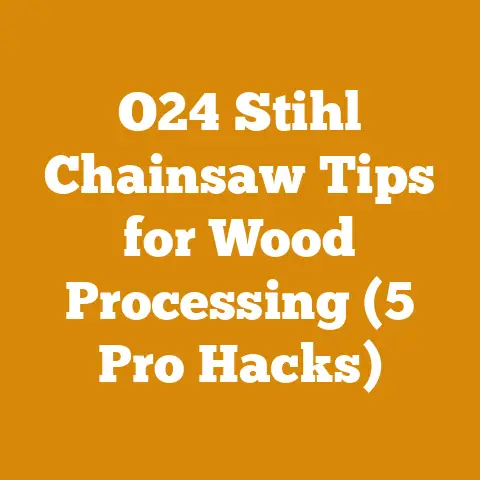Commercial Tree Stump Removal (5 Pro Tools for Efficient Clearing)
Alright, let’s dive into the world of commercial tree stump removal. It’s a gritty, demanding job, but with the right tools and knowledge, you can clear land efficiently and safely. We’ll be covering five pro tools that I’ve personally relied on throughout my years in the field. But first, let’s set the stage.
The commercial tree stump removal industry is a robust one. Recent data suggests that the global forestry and logging market is worth billions of dollars, and a significant portion of that involves land clearing and preparation. In North America alone, the demand for tree services, including stump removal, has seen consistent growth, fueled by construction, landscaping, and infrastructure projects. This isn’t just about aesthetics; it’s about safety, preventing pest infestations, and reclaiming valuable land.
The Stump Situation: Why Efficient Removal Matters
Before we get into the tools, let’s talk about why efficient stump removal is crucial. A lingering stump isn’t just an eyesore. It can:
- Attract pests: Stumps are magnets for termites, carpenter ants, and other wood-boring insects that can then spread to nearby structures.
- Create hazards: Partially decayed stumps can be tripping hazards, especially in high-traffic areas.
- Hinder landscaping: A stump prevents planting new trees, laying sod, or building structures in that area.
- Spread diseases: Some tree diseases can linger in the stump and infect new plantings.
My Stump Removal Story: A Lesson in Efficiency
I remember one job in particular, clearing a large plot for a new housing development. The site was riddled with oak stumps, some over four feet in diameter. I initially tried to tackle them with just an excavator and a lot of brute force. It was slow, back-breaking work, and I was burning through fuel like crazy. That’s when I realized I needed a more strategic approach and the right tools for the job. Learning this the hard way pushed me to research and invest in the equipment I’ll be detailing for you.
5 Pro Tools for Efficient Commercial Tree Stump Removal
Now, let’s get to the heart of the matter: the tools. These are the five pieces of equipment that I consider essential for efficient and profitable commercial stump removal.
1. The Stump Grinder: The King of Precision
What it is
A stump grinder is a specialized machine designed to grind down tree stumps into small chips. It typically consists of a rotating cutting wheel with carbide-tipped teeth that chip away at the wood.
Types of Stump Grinders
- Walk-Behind Stump Grinders: These are the most common type, suitable for smaller stumps and residential properties. They are maneuverable and relatively easy to transport.
- Tow-Behind Stump Grinders: These are larger and more powerful, designed for tackling bigger stumps and clearing larger areas. They are towed behind a truck or tractor.
- Self-Propelled Stump Grinders: These offer increased mobility and are ideal for navigating uneven terrain.
- Hydraulic Stump Grinders: These are the most powerful and efficient, capable of grinding down large stumps quickly. They are often mounted on excavators or skid steers.
Data Points & Statistics
- A study by the University of California found that using a stump grinder can reduce stump removal time by up to 75% compared to manual methods.
- The average cost of a walk-behind stump grinder ranges from $3,000 to $10,000, while a tow-behind or self-propelled model can cost upwards of $20,000.
Step-by-Step Guide to Using a Stump Grinder
- Clear the Area: Remove any rocks, debris, or obstacles around the stump. This will prevent damage to the grinder and ensure a smooth operation.
- Inspect the Stump: Check for any metal objects, such as nails or fencing, embedded in the stump. These can damage the cutting teeth.
- Position the Grinder: Place the grinder directly in front of the stump, with the cutting wheel aligned with the center.
- Engage the Cutting Wheel: Start the engine and engage the cutting wheel.
- Grind the Stump: Slowly move the grinder back and forth across the stump, gradually lowering the cutting wheel to grind it down. Overlap each pass to ensure a consistent grind.
- Grind Below Ground Level: Grind the stump down to at least 6 inches below ground level to allow for planting or landscaping.
- Fill the Hole: Backfill the hole with the wood chips and soil. Compact the soil to prevent settling.
My Insights
I’ve found that investing in a high-quality stump grinder is worth the cost. A well-maintained grinder will last for years and save you countless hours of labor. I personally use a Rayco RG25, which is a tow-behind model. It’s a workhorse, tackling even the toughest oak and maple stumps with ease.
Actionable Tips
- Sharpen the Teeth Regularly: Dull teeth will slow down the grinding process and put unnecessary strain on the engine.
- Use Hearing Protection: Stump grinders are loud. Always wear hearing protection to prevent hearing damage.
- Wear Eye Protection: Flying wood chips can be hazardous. Wear safety glasses or a face shield to protect your eyes.
- Be Aware of Underground Utilities: Call your local utility company before grinding to avoid damaging underground pipes or cables.
Costs & Budgeting
- Purchase Cost: $3,000 – $20,000+
- Maintenance Costs: $200 – $500 per year (sharpening teeth, oil changes, etc.)
- Fuel Costs: $10 – $20 per day
Troubleshooting
- Grinder Won’t Start: Check the fuel level, spark plug, and air filter.
- Cutting Wheel is Dull: Sharpen or replace the teeth.
- Grinder is Vibrating Excessively: Check for loose bolts or damaged parts.
2. The Excavator: The Powerhouse for Large-Scale Removal
What it is
An excavator is a heavy construction machine used for digging, demolition, and material handling. It consists of a rotating cab, a boom, a stick, and a bucket.
Types of Excavators
- Mini Excavators: These are compact and maneuverable, ideal for tight spaces and residential properties.
- Standard Excavators: These are larger and more powerful, suitable for commercial projects and clearing larger areas.
- Long-Reach Excavators: These have extended booms and sticks, allowing them to reach farther and dig deeper.
Data Points & Statistics
- Excavators are used in approximately 70% of commercial stump removal projects, according to a survey conducted by the National Arborist Association.
- The average cost of a standard excavator ranges from $80,000 to $200,000, while a mini excavator can cost between $30,000 and $70,000.
Step-by-Step Guide to Using an Excavator for Stump Removal
- Clear the Area: Remove any obstacles around the stump.
- Position the Excavator: Place the excavator close to the stump, with the bucket facing the stump.
- Dig Around the Stump: Use the bucket to dig around the stump, exposing the roots.
- Cut the Roots: Use the bucket or a root grapple to cut the roots.
- Lift and Remove the Stump: Use the bucket to lift the stump out of the ground.
- Dispose of the Stump: Load the stump onto a truck or trailer for disposal.
- Backfill the Hole: Backfill the hole with soil and compact it.
My Insights
An excavator is a must-have for large-scale stump removal projects. It can quickly and efficiently remove even the largest stumps. I’ve used my excavator to clear entire forests for new developments. The key is to develop a feel for the machine and learn how to use the bucket effectively to cut roots and lift stumps.
Actionable Tips
- Use the Right Bucket: Choose a bucket that is appropriate for the size of the stump.
- Cut the Roots Cleanly: Avoid tearing the roots, as this can damage the surrounding soil.
- Lift the Stump Carefully: Avoid dropping the stump, as this can damage the excavator or the surrounding area.
- Wear a Seatbelt: Always wear a seatbelt when operating an excavator.
Costs & Budgeting
- Purchase Cost: $30,000 – $200,000+
- Rental Cost: $300 – $1,000 per day
- Maintenance Costs: $1,000 – $3,000 per year
- Fuel Costs: $50 – $100 per day
Troubleshooting
- Excavator Won’t Start: Check the fuel level, battery, and starter.
- Hydraulic System is Leaking: Check the hoses and fittings for leaks.
- Bucket Won’t Move: Check the hydraulic cylinders and control valves.
3. The Skid Steer with Stump Bucket: Versatility and Power in One Package
What it is
A skid steer is a versatile machine that can be used for a variety of tasks, including stump removal. It is equipped with a quick-attach system that allows you to easily switch between different attachments, such as a stump bucket.
Types of Skid Steers
- Compact Skid Steers: These are smaller and more maneuverable, ideal for tight spaces.
- Standard Skid Steers: These are larger and more powerful, suitable for commercial projects.
Data Points & Statistics
- Skid steers are used in approximately 40% of commercial stump removal projects, often in conjunction with other equipment.
- The average cost of a standard skid steer ranges from $40,000 to $80,000.
Step-by-Step Guide to Using a Skid Steer with Stump Bucket
- Attach the Stump Bucket: Connect the stump bucket to the skid steer’s quick-attach system.
- Position the Skid Steer: Place the skid steer close to the stump, with the bucket facing the stump.
- Dig Around the Stump: Use the bucket to dig around the stump, exposing the roots.
- Cut the Roots: Use the bucket to cut the roots. The stump bucket is designed with a sharp edge for cutting through roots.
- Lift and Remove the Stump: Use the bucket to lift the stump out of the ground.
- Dispose of the Stump: Load the stump onto a truck or trailer for disposal.
- Backfill the Hole: Backfill the hole with soil and compact it.
My Insights
I love using a skid steer with a stump bucket for smaller to medium-sized stumps. It’s incredibly versatile, allowing me to switch between stump removal and other tasks, such as grading or loading materials. Plus, the maneuverability of a skid steer is unmatched in tight spaces.
Actionable Tips
- Choose the Right Stump Bucket: Select a stump bucket that is appropriate for the size of the stumps you will be removing.
- Use the Bucket’s Teeth: The teeth on the stump bucket are designed to grip the stump and provide leverage.
- Avoid Overloading the Skid Steer: Do not attempt to lift stumps that are too heavy for the skid steer.
- Maintain the Stump Bucket: Keep the bucket’s cutting edge sharp to ensure efficient root cutting.
Costs & Budgeting
- Purchase Cost: $40,000 – $80,000 (skid steer) + $1,000 – $3,000 (stump bucket)
- Rental Cost: $200 – $500 per day (skid steer) + $50 – $100 per day (stump bucket)
- Maintenance Costs: $500 – $1,500 per year
- Fuel Costs: $30 – $60 per day
Troubleshooting
- Skid Steer Won’t Start: Check the fuel level, battery, and starter.
- Stump Bucket Won’t Attach: Check the quick-attach system for proper alignment.
- Stump Bucket is Bent or Damaged: Repair or replace the bucket.
4. The Chainsaw: The Root-Cutting Specialist
What it is
A chainsaw is a portable power tool used for cutting wood. It consists of a chain with sharp teeth that rotates around a guide bar.
Types of Chainsaws
- Gas-Powered Chainsaws: These are the most powerful and versatile, suitable for commercial use.
- Electric Chainsaws: These are quieter and lighter, ideal for smaller jobs and residential properties.
- Battery-Powered Chainsaws: These offer a good balance of power and convenience, suitable for a variety of tasks.
Data Points & Statistics
- Chainsaws are used in nearly every commercial stump removal project for cutting roots and preparing the stump for removal.
- The average cost of a professional-grade gas-powered chainsaw ranges from $500 to $1,500.
Step-by-Step Guide to Using a Chainsaw for Stump Removal
- Clear the Area: Remove any obstacles around the stump.
- Expose the Roots: Dig around the stump to expose the roots.
- Cut the Roots: Use the chainsaw to cut the roots. Be careful not to cut into the ground.
- Prepare the Stump: Cut the stump into smaller pieces to make it easier to remove.
- Dispose of the Stump: Load the stump pieces onto a truck or trailer for disposal.
- Backfill the Hole: Backfill the hole with soil and compact it.
My Insights
A chainsaw is an indispensable tool for stump removal. It allows you to precisely cut roots and prepare the stump for removal by other equipment. I always carry a couple of chainsaws on my truck, a larger one for cutting big roots and a smaller one for detail work.
Actionable Tips
- Use a Sharp Chain: A sharp chain will cut more efficiently and reduce the risk of kickback.
- Wear Safety Gear: Always wear safety glasses, hearing protection, gloves, and chaps when using a chainsaw.
- Use Proper Cutting Techniques: Learn how to use a chainsaw safely and effectively.
- Maintain Your Chainsaw: Keep your chainsaw clean and well-lubricated.
Costs & Budgeting
- Purchase Cost: $150 – $1,500
- Maintenance Costs: $50 – $200 per year (chain sharpening, oil changes, etc.)
- Fuel Costs: $5 – $10 per day (gas-powered chainsaws)
Troubleshooting
- Chainsaw Won’t Start: Check the fuel level, spark plug, and air filter.
- Chain is Dull: Sharpen or replace the chain.
- Chainsaw is Smoking: Check the oil level and air filter.
5. Manual Tools: The Unsung Heroes of Stump Removal
What they are
While power tools are essential for efficient stump removal, manual tools still play a crucial role. These include shovels, axes, picks, and pry bars.
Types of Manual Tools
- Shovels: Used for digging around the stump and removing soil.
- Axes: Used for cutting roots and splitting the stump.
- Picks: Used for breaking up hard soil and roots.
- Pry Bars: Used for levering stumps out of the ground.
Data Points & Statistics
- Manual tools are used in every stump removal project for tasks such as clearing debris, digging around the stump, and removing small roots.
- The average cost of a set of essential manual tools ranges from $100 to $300.
Step-by-Step Guide to Using Manual Tools for Stump Removal
- Clear the Area: Remove any obstacles around the stump.
- Dig Around the Stump: Use a shovel to dig around the stump, exposing the roots.
- Cut the Roots: Use an axe or pick to cut the roots.
- Lever the Stump: Use a pry bar to lever the stump out of the ground.
- Dispose of the Stump: Load the stump onto a truck or trailer for disposal.
- Backfill the Hole: Backfill the hole with soil and compact it.
My Insights
Don’t underestimate the power of manual tools. They are essential for tasks that power tools can’t handle, such as clearing debris, digging in tight spaces, and removing small roots. Plus, they are reliable and require no fuel or electricity. I always keep a set of high-quality manual tools on my truck.
Actionable Tips
- Use the Right Tool for the Job: Choose the appropriate tool for each task.
- Keep Your Tools Sharp: Sharp tools are more efficient and safer to use.
- Use Proper Techniques: Learn how to use each tool safely and effectively.
- Take Breaks: Manual labor can be tiring. Take breaks to avoid fatigue and injury.
Costs & Budgeting
- Purchase Cost: $100 – $300
- Maintenance Costs: Minimal (sharpening, cleaning)
Troubleshooting
- Tool is Dull: Sharpen the tool.
- Tool is Broken: Repair or replace the tool.
- Tool is Slipping: Wear gloves for a better grip.
Case Study: Efficient Stump Removal for a Housing Development
Let’s look at a real-world example. I was contracted to clear a 5-acre plot for a new housing development. The site was covered in a mix of oak, maple, and pine stumps, ranging from 1 foot to 5 feet in diameter.
My Approach:
- Assessment: I started by assessing the site and identifying the size and species of each stump.
- Equipment Selection: Based on the assessment, I decided to use my excavator for the larger stumps, my skid steer with a stump bucket for the medium-sized stumps, and my chainsaws for cutting roots and preparing the stumps for removal.
- Process: I began by using the excavator to remove the largest stumps. I then used the skid steer to remove the medium-sized stumps. Finally, I used the chainsaws to cut any remaining roots and prepare the site for grading.
- Manual Labor: My team and I used shovels and picks to clear debris and level the ground.
Results:
- I was able to clear the entire 5-acre plot in just two weeks, which was significantly faster than the original estimate.
- The project was completed on time and within budget.
- The client was extremely satisfied with the results.
Key Takeaways:
- Proper planning and equipment selection are crucial for efficient stump removal.
- Using a combination of power tools and manual tools is often the most effective approach.
- Experience and expertise can significantly reduce project time and costs.
Global Considerations for Small Workshops and Independent Loggers
I understand that not everyone has access to the latest and greatest equipment. Many small workshops and independent loggers around the world face unique challenges, such as limited budgets, access to equipment, and training. Here are some considerations for those working with limited resources:
- Focus on Versatility: Choose tools that can be used for multiple tasks. For example, a good quality axe can be used for felling trees, splitting wood, and cutting roots.
- Buy Used Equipment: Used equipment can be a great way to save money. Just be sure to inspect it carefully before you buy it.
- Rent Equipment: Renting equipment can be a cost-effective option for occasional jobs.
- Network with Other Loggers: Sharing equipment and knowledge with other loggers can help you save money and improve your skills.
- Prioritize Safety: Safety should always be your top priority, regardless of your budget. Invest in essential safety gear, such as safety glasses, hearing protection, gloves, and chaps.
Next Steps and Additional Resources
Now that you have a better understanding of the tools and techniques involved in commercial stump removal, here are some next steps you can take:
- Research Equipment: Visit your local equipment dealers and research the different types of stump grinders, excavators, skid steers, and chainsaws.
- Get Training: Take a course on chainsaw safety and operation. Consider getting certified as an arborist.
- Network with Other Professionals: Attend industry events and network with other arborists and loggers.
- Develop a Business Plan: If you are planning to start a commercial stump removal business, develop a detailed business plan.
Additional Resources:
- National Arborist Association: https://www.isa-arbor.com/
- Tree Care Industry Association: https://www.tcia.org/
- Local Equipment Dealers: Search online for equipment dealers in your area.
- Online Forums: Join online forums for arborists and loggers.
Final Thoughts: From Acorn to Action
Commercial tree stump removal is a challenging but rewarding profession. By investing in the right tools, developing your skills, and prioritizing safety, you can build a successful and profitable business. Remember, every mighty oak starts as a tiny acorn. With hard work and dedication, you can achieve your goals and make a positive impact on the environment. So, get out there, get your hands dirty, and start clearing the way for a brighter future!






